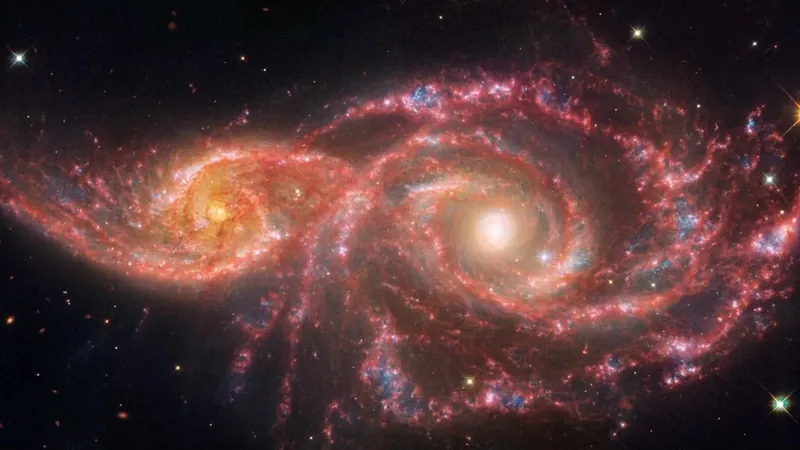
Stunning Cosmic Encounter: Dive into the 'Bloodshot Eyes' of a Mysterious Galaxy Pair
2024-11-17
Author: Wai
A Breathtaking Cosmic Display
In a breathtaking cosmic display, astronomers have recently unveiled a striking image capturing the unique interaction between two spiral galaxies, IC 2163 (on the left) and NGC 2207 (on the right), located a staggering 80 million light-years away in the constellation Canis Major. This incredible image, shared on October 31, 2024, combines the advanced imaging capabilities of both the James Webb Space Telescope (JWST) and the Hubble Space Telescope to showcase a scene that's both beautiful and eerie.
The 'Bloodshot Eyes' of the Galaxies
What makes these galaxies particularly captivating is their resemblance to "bloodshot eyes." This haunting image reveals a pair of galaxies that grazed each other millions of years ago and are now in the throes of a spectacular collision. As IC 2163 drifted behind its larger counterpart NGC 2207, the gravitational forces at play began to stretch and distort their shapes, leading to what are described as "tail-like extensions" in their spirals, particularly prominent in the bright red regions that outline their "eyelids."
Prolific Star Factories
Beyond the aesthetics, these galaxies are also prolific star factories. IC 2163 and NGC 2207 produce nearly two dozen new sunlike stars annually, far surpassing the Milky Way's output of just two-to-three stars per year. This accelerated star formation is intricately linked to the numerous supernova events that have transpired in these galaxies. In fact, both galaxies have witnessed seven supernova explosions in recent decades, which not only illuminate the galaxies but also play a crucial role in the cosmic cycle of star formation. When these massive stars explode, they clear out space within the spiral arms, allowing gas and dust to accumulate and cool, prompting the birth of new stars in areas known as super star clusters.
A Stunning Image
The image effectively showcases the star-forming regions, depicted in bright blue from Hubble's observations, and in vibrant pink and white from the JWST's mid-infrared imaging. Some particularly bright areas may indicate mini-starbursts, where stars are forming at an exceptionally high rate.
The Future of IC 2163 and NGC 2207
Looking to the future, the journey of these galaxies is even more intriguing. Over time, IC 2163 and NGC 2207 will draw closer, entering a cosmic dance. As their orbits become tighter and they continue to interact, they are destined to merge into a single galaxy, leading to the creation of a reshaped spiral with a singular, brighter core. In a billion years or so, this captivating scene will ultimately transform into one unified "eye," forever changing the landscape of the cosmos.
Conclusion
This stunning interplay of forces not only highlights the dynamic nature of galaxies but also invites us to ponder the vast, unseen processes that shape our universe. Keep an eye out for more captivating astronomical phenomena as we expand our understanding of the cosmos!

 Brasil (PT)
Brasil (PT)
 Canada (EN)
Canada (EN)
 Chile (ES)
Chile (ES)
 España (ES)
España (ES)
 France (FR)
France (FR)
 Hong Kong (EN)
Hong Kong (EN)
 Italia (IT)
Italia (IT)
 日本 (JA)
日本 (JA)
 Magyarország (HU)
Magyarország (HU)
 Norge (NO)
Norge (NO)
 Polska (PL)
Polska (PL)
 Schweiz (DE)
Schweiz (DE)
 Singapore (EN)
Singapore (EN)
 Sverige (SV)
Sverige (SV)
 Suomi (FI)
Suomi (FI)
 Türkiye (TR)
Türkiye (TR)